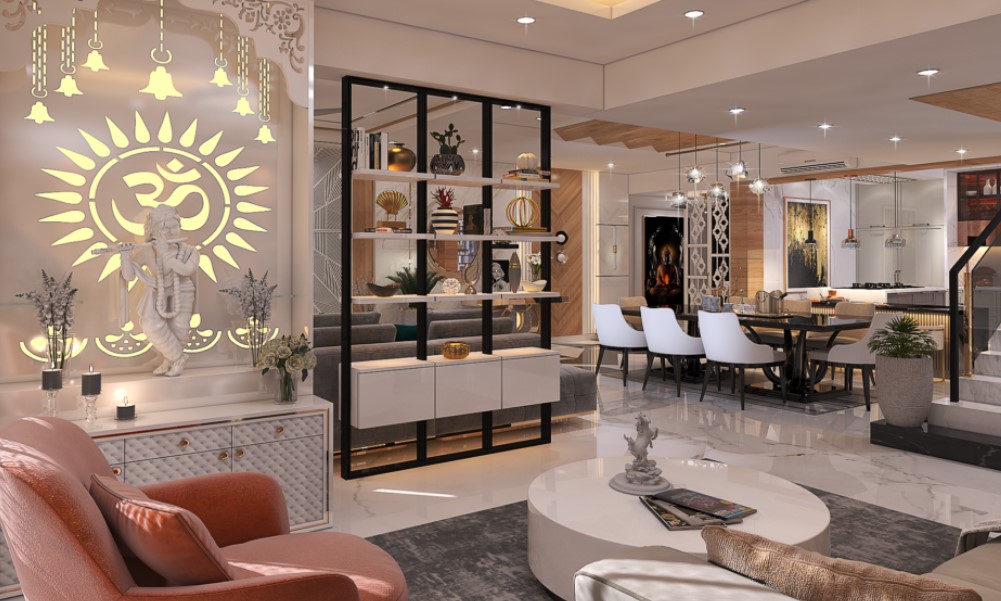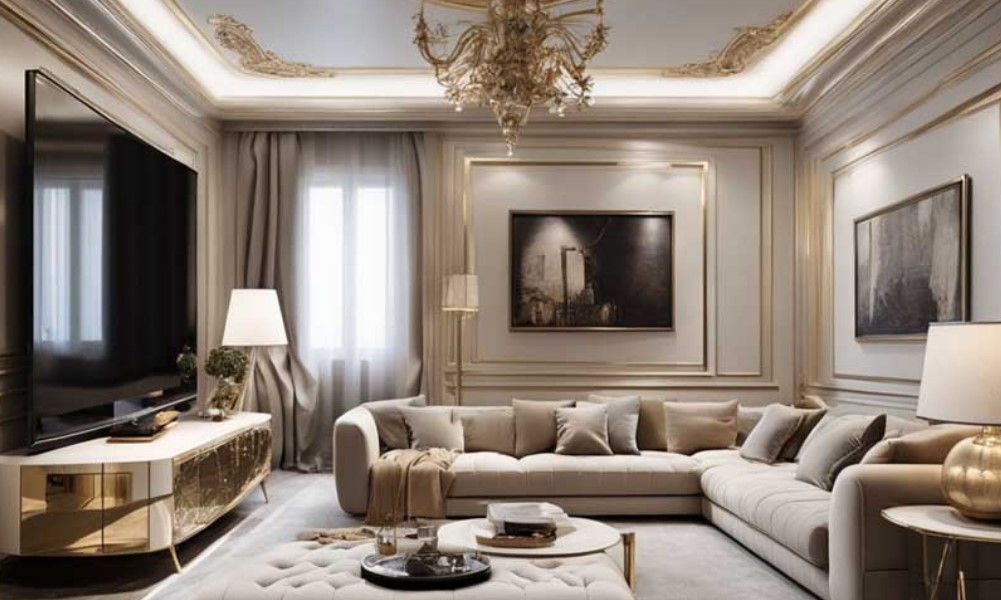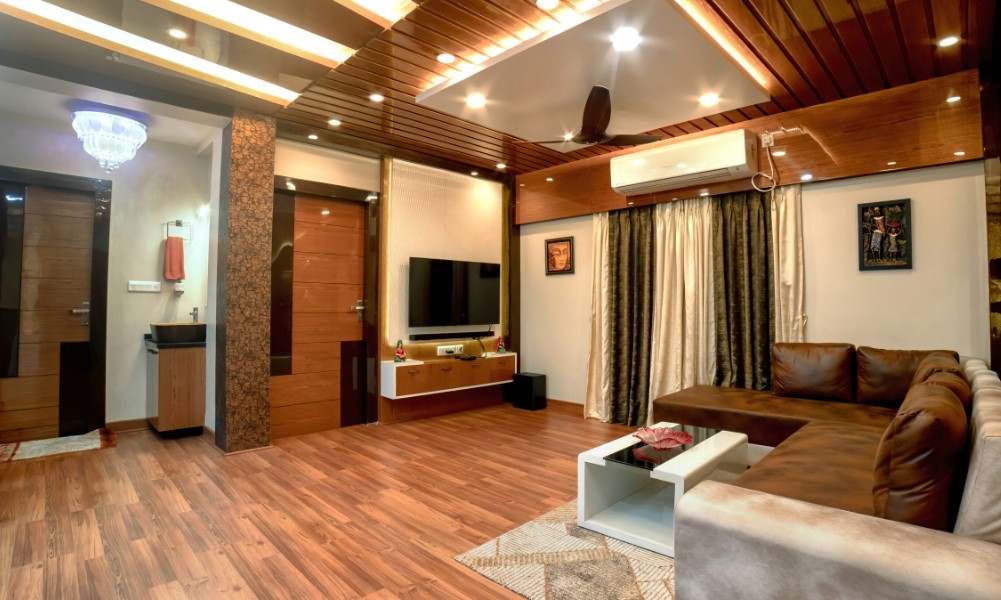Home Interior Design refers to the process of planning, designing, and furnishing the interior spaces of a residential home. It involves transforming the layout, aesthetics, and functionality of rooms to create a cohesive and visually pleasing environment that aligns with the homeowner’s preferences and lifestyle.
Effective home interior design not only focuses on aesthetic appeal but also prioritizes functionality, comfort, and the practical needs of the occupants. It involves collaboration between homeowners and interior designers or decorators to create spaces that are both beautiful and livable, tailored to enhance daily living experiences within the home.
What Is Home Interior Design?

Home interior design refers to the art and science of enhancing the interior of a residential space to create a more aesthetically pleasing and functional environment. It involves carefully planning, organizing, and coordinating various elements such as furniture, color schemes, lighting, textures, materials, and decorative accessories to achieve a cohesive and harmonious look.
The goal of home interior design is to improve the quality of living for the occupants by optimizing the use of available space while reflecting their personal tastes and preferences. It encompasses both practical considerations, such as maximizing functionality and comfort, as well as artistic aspects, such as creating a visually appealing atmosphere that resonates with the homeowner’s lifestyle.
Professional interior designers utilize their expertise to conceptualize and execute designs that not only beautify residential spaces but also enhance their functionality. They work closely with clients to understand their needs, preferences, and budget constraints, translating these into cohesive design plans that integrate style, functionality, and practicality.
Key Principles of Interior Design

Interior design is more than just arranging furniture and choosing colors; it’s about creating harmonious, functional, and aesthetically pleasing spaces that enhance the quality of life. The key principles of interior design guide professionals and homeowners alike in achieving cohesive and well-balanced interiors.
Mastering the key principles of interior design empowers designers and homeowners to create spaces that are not only visually appealing but also functional, comfortable, and reflective of personal style. Here are the fundamental principles that define successful interior design:
Unity and Harmony
Unity refers to the coherence and consistency of a design. It ensures that all elements in a space work together to create a harmonious whole. Achieving unity involves maintaining consistency in style, color schemes, and materials throughout the room or home.
This doesn’t mean everything has to match perfectly but rather that there should be a sense of cohesion and interconnectedness among the various elements.
Balance
Balance is the distribution of visual weight in a room. It can be achieved through symmetrical, asymmetrical, or radial balance. Symmetrical balance involves mirroring elements evenly around a central axis, while asymmetrical balance relies on visual weight and contrast to achieve equilibrium.
Radial balance is organized around a central point, often seen in circular or starburst patterns. Balancing elements such as furniture, artwork, and lighting helps create a sense of stability and order in the space.
Rhythm and Repetition
Rhythm refers to the visual flow and movement created by the repetition of elements in a space. It can be achieved through patterns, colors, textures, or shapes that repeat in a deliberate manner.
Rhythm helps guide the eye around the room and creates a sense of coherence and visual interest. Alternating elements and creating a rhythmical progression can add dynamism and energy to the design while maintaining a cohesive look.
Scale and Proportion
Scale refers to the size of objects in relation to the space they occupy, while proportion is the relationship between these objects. Choosing furniture, artwork, and accessories that are appropriately scaled to the room ensures that everything feels balanced and comfortable.
Oversized or undersized elements can disrupt the visual harmony of a space. Proportionate relationships between different elements help maintain a sense of equilibrium and ensure that no single piece overwhelms the rest of the design.
Emphasis and Focal Point
Emphasis creates a point of interest or focal point in a room. It draws attention and serves as the center of visual gravity. Focal points can be architectural features like fireplaces or large windows, or they can be created through furniture arrangements, artwork, or decorative accessories.
Establishing a focal point helps organize the space and gives it a sense of hierarchy, guiding the eye and providing a visual anchor for the design.
Functionality and Practicality
Interior design must prioritize functionality to ensure that spaces not only look good but also serve their intended purposes effectively. Designers consider the needs and lifestyles of the occupants when planning layouts, selecting furniture, and arranging spaces.
Practical considerations such as traffic flow, storage solutions, and ergonomic furniture placement contribute to the overall usability and comfort of the space.
Lighting and Ambiance
Lighting plays a crucial role in interior design by influencing the mood, ambiance, and functionality of a space. Effective lighting design combines natural and artificial light sources to create layers of illumination that enhance different activities and highlight architectural features or focal points.
Ambient, task, and accent lighting are strategically used to create atmosphere, define spatial zones, and complement the overall design aesthetic.
Elements of Interior Design

Interior design is a multifaceted discipline that combines creativity with practicality to enhance the functionality, aesthetics, and overall appeal of interior spaces. The effective use of various elements is essential in creating well-designed interiors that reflect personal style, optimize usability, and evoke desired emotions. Here are the key elements of interior design that shape and define successful spaces:
Furniture & Fixtures
Furniture and fixtures are essential components of home interior design, influencing the layout, functionality, and aesthetic appeal of living spaces.
By carefully selecting and arranging furniture that balances style and comfort, and integrating fixtures that enhance both usability and visual appeal, designers create environments that are not only beautiful but also practical and tailored to the needs and preferences of homeowners.
Furniture
- Functionality and Comfort: Furniture serves as the backbone of interior spaces, providing essential functions such as seating, storage, and work surfaces. The choice of furniture depends on the room’s purpose and the lifestyle of its occupants. For example, living rooms often feature sofas, armchairs, and coffee tables that promote relaxation and socializing, while dining rooms require tables and chairs conducive to meals and gatherings.
- Style and Aesthetics: Furniture acts as a visual anchor in a room, contributing to its design style and personality. Whether contemporary, traditional, rustic, or eclectic, furniture sets the tone for the overall decor scheme. Designers often mix different styles or incorporate statement pieces to add character and interest. Upholstery fabrics, wood finishes, and metal accents further enhance the visual appeal and cohesiveness of the design.
- Scale and Proportion: Properly scaled furniture is crucial for achieving balance and harmony within a space. Oversized or undersized pieces can disrupt the flow and functionality of a room. Designers consider the dimensions of the room and the furniture’s proportions relative to other elements to ensure a comfortable and visually pleasing arrangement.
- Space Planning: Effective space planning involves arranging furniture in a way that maximizes usability and circulation. Traffic patterns, natural focal points (such as windows or fireplace), and functional zones (like conversation areas or workspaces) influence furniture placement. Strategic positioning creates a sense of openness and facilitates ease of movement within the room.
- Multifunctionality: In modern interior design, multifunctional furniture is increasingly popular for its space-saving capabilities and versatility. Examples include sleeper sofas that double as guest beds, extendable dining tables for accommodating larger gatherings, and storage ottomans that provide both seating and organizational space. Such pieces optimize square footage without compromising style or comfort.
Fixtures
- Essential Elements: Fixtures encompass a range of permanent installations in a home, including lighting fixtures, plumbing fixtures, and built-in features such as cabinets and shelving units. These elements contribute to the functionality and architectural integrity of a space while enhancing its aesthetic appeal.
- Lighting Fixtures: Lighting fixtures serve both practical and decorative purposes, illuminating rooms and creating ambiance. Examples include chandeliers, pendant lights, recessed lighting, and wall sconces. Properly layered lighting enhances visibility, highlights focal points, and sets the mood for different activities within a room.
- Plumbing Fixtures: In bathrooms and kitchens, plumbing fixtures such as faucets, sinks, showers, and bathtubs are essential for daily use. These fixtures come in a variety of styles, finishes, and configurations to complement different design themes from sleek modern designs to timeless classics. High-quality plumbing fixtures not only add functionality but also contribute to the overall luxury and comfort of these spaces.
- Built-in Features: Built-in fixtures like cabinets, shelving units, and fireplace surrounds are customized to fit specific dimensions and design preferences. They maximize storage space, display opportunities, and architectural cohesion within a room. Built-ins can be tailored to blend seamlessly with the overall decor or serve as statement pieces that enhance the room’s character and functionality.
Lighting Solutions
In home interior design, lighting serves as a critical element that influences both the functionality and ambiance of a space. Thoughtfully planned lighting solutions can enhance visual appeal, create mood, and improve usability in various rooms throughout the home. Here’s an exploration of different lighting solutions commonly used in interior design:
Ambient Lighting
- Chandeliers: Elegant and decorative fixtures that provide ambient light while adding a touch of sophistication and style to dining rooms, entryways, or living rooms.
- Flush Mounts and Semi-Flush Mounts: Ceiling fixtures that are close to the ceiling and spread light evenly across the room. They are ideal for spaces with lower ceilings or where a streamlined look is desired.
- Recessed Lighting: Installed into the ceiling, recessed lights are versatile and can provide ambient light without taking up visual space. They are commonly used in kitchens, hallways, and bathrooms.
Task Lighting
- Pendant Lights: Suspended from the ceiling over kitchen islands, dining tables, or workspaces to provide targeted light for tasks below.
- Under Cabinet Lighting: Installed beneath kitchen cabinets to illuminate countertops and provide task lighting for food preparation and cooking.
- Desk Lamps: Adjustable lamps placed on desks or worktables to provide focused light for reading, writing, or working on projects.
Decorative Lighting
- Statement Chandeliers: Elaborate and eye-catching fixtures that serve as focal points in dining rooms, entryways, or living rooms, while also providing ambient light.
- Sculptural Floor Lamps: Floor-standing lamps with unique designs that contribute to the decor of a room while providing ambient or task lighting.
- Table Lamps: Decorative lamps placed on side tables, nightstands, or console tables to add warmth and ambiance to living spaces.
Room Specific Design Ideas

Room specific design ideas are crucial for creating functional and aesthetically pleasing spaces tailored to the unique purposes of each room in a home.
By focusing on these room-specific design ideas, homeowners can create spaces that not only meet practical needs but also reflect their personal style and enhance overall living comfort.Here are some tailored suggestions for key rooms:
Living Room
The living room serves as a central gathering place for relaxation and entertainment. Design considerations include:
- Seating Arrangement: Create conversational groupings with sofas, armchairs, and coffee tables arranged to facilitate interaction.
- Focal Point: Design around a central element such as a fireplace, large window with a view, or media center.
- Ambiance: Use ambient lighting like floor lamps and table lamps to create a warm and inviting atmosphere. Incorporate soft textures with throw pillows, area rugs, and curtains.
Kitchen
The kitchen is a functional space that blends cooking, dining, and socializing. Design elements to focus on include:
- Layout Efficiency: Optimize workflow with a functional triangle between the sink, stove, and refrigerator.
- Storage Solutions: Maximize cabinet and drawer space with organizers and pull-out shelves for easy access.
- Lighting: Install task lighting under cabinets and pendant lights above islands or dining areas for focused illumination.
Bedroom
The bedroom is a personal retreat for rest and relaxation. Key design ideas include:
- Comfortable Bedding: Invest in quality mattresses and bedding for a restful sleep environment.
- Color Palette: Choose soothing colors like soft blues, greens, or neutrals to promote relaxation.
- Personal Touches: Incorporate personal items, artwork, or photographs to personalize the space.
- Functional Storage: Integrate storage solutions such as bedside tables, dressers, or built-in closets to maintain organization.
Bathroom
The bathroom combines functionality with comfort and style. Design elements to consider include:
- Layout Optimization: Ensure efficient use of space with well-placed fixtures and storage.
- Lighting: Incorporate task lighting around the vanity mirror and ambient lighting for overall brightness.
- Materials and Finishes: Select durable materials for surfaces like countertops, tiles, and flooring that are also easy to maintain.
- Spa-like Features: Enhance the atmosphere with features such as a rainfall showerhead, heated towel racks, or aromatherapy diffusers for a luxurious feel.
